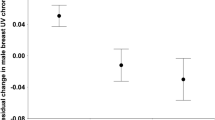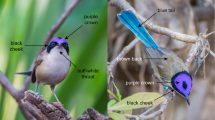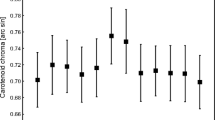Abstract
We investigated potential information content in red carotenoid-based undertail coverts of 28 pairs of breeding Great Spotted Woodpeckers by comparing plumage reflectance to measures of body condition and reproductive success. Plumage coloration was not significantly associated with sex or age, and did not correlate with body condition or the number of offspring fledged. Further, we found no evidence of assortative mating related to plumage colour. Our research provides an example of an exception from the commonly held hypothesis that carotenoid-based plumage coloration signals individual condition. Future surveys incorporating other plumage traits and physiological measures of condition in Great Spotted Woodpeckers are needed to verify our findings.
Zusammenfassung
Keine Belege für den potenziellen sexuellen Informationsgehalt eines monochromatischen Carotinoidmerkmals bei einer dichromatischen Spechtart. Wir haben den potenziellen Informationsgehalt der roten carotinoidbasierten Unterschwanzdecken von 28 Buntspecht-Brutpaaren untersucht, indem wir die Reflexion des Gefieders mit Maßen der Köperkondition und des Fortpflanzungserfolgs verglichen haben. Die Gefiederfärbung hing nicht signifikant mit Geschlecht oder Alter zusammen und korrelierte nicht mit der Körperkondition oder der Anzahl ausgeflogener Jungvögel. Zudem fanden wir keine Belege für assortative Paarung in Bezug auf die Gefiederfärbung. Unsere Forschung liefert ein Beispiel für eine Ausnahme von der allgemein vertretenen Hypothese, dass carotinoidbasierte Gefiederfärbung die individuelle Kondition signalisiert. Zukünftige Studien, die andere Gefiedermerkmale und physiologische Konditionsmaße von Buntspechten betrachten, sind nötig, um unsere Befunde zu bestätigen.




Similar content being viewed by others
Data availability (data transparency)
The data that support the findings of this study are available from the corresponding author upon reasonable request.
Code availability (software application or custom code)
Not applicable.
References
Andersson S, Prager M (2006) Quantifying colours. In: Hill GE, McGraw KJ (eds) Bird coloration, volume I: mechanisms and measurements. Harvard University Press, Cambridge, MA, USA, pp 41–89
Arnold TW, Green AJ (2007) On the allometric relationship between size and composition of avian eggs: a reassessment. Condor 109:705–714
Badyaev AV, Hill GE (2000) Evolution of sexual dichromatism: contribution of carotenoid-versus melanin-based coloration. Biol J Linn Soc 69:153–172
Bulluck LP, Foster MJ, Kay S, Cox DE, Viverette C, Huber S (2017) Feather carotenoid content is correlated with reproductive success and provisioning rate in female Prothonotary Warblers. The Auk: Ornithol Adv 134:229–239
Caro S, Pierre L, Bergès M, Bakker R, Doutrelant C, Bonadonna F (2021) Mutual mate preferences and assortative mating in relation to a carotenoid-based color trait in Blue Tits. Behav Ecol 32:1171–1182
Cuthill IC (2006) Color perception. In: Hill GE, McGraw KJ (eds) Bird coloration, volume I: mechanisms and measurements. Harvard University Press, Cambridge, MA, USA, pp 3–40
Dale J, Dey C, Delhey K, Kempenaers B, Valcu M (2015) The effects of life-history and social selection on male and female plumage coloration. Nature 527:367–370
del Hoyo J, Elliott A, Sargatal J, Christie DA, Kirwan G (2019) Handbook of the birds of the world alive. Lynx Edicions, Barcelona
Doutrelant C, Grégoire A, Grnac N, Gomez D, Lambrechts MM, Perret P (2008) Female coloration indicates female reproductive capacity in Blue Tits. J Evol Bio 21:226–233
Endler AU, Friedl TW (2012) Age-related variation in carotenoid-based plumage ornaments of male Red Bishops Euplectes orix. J Ornithol 153:413–420
Estep LK, Shawkey MD, Hill GE (2006) Carotenoid-based breast plumage colour, body condition and clutch size in Red Fodies (Foudia madagascariensis). Ostrich 77:164–169
Fernandez-Eslava B, Alonso D, Alonso-Alvarez C (2021) An age-related decline in the expression of a red carotenoid-based ornament in wild birds. Evolution 75:3142–3153
Flockhart DT, Wiebe KL (2007) The role of weather and migration in assortative pairing within the Northern Flicker (Colaptes auratus) hybrid zone Evolutionary. Evol Ecol Res 9:887–903
Griggio M, Devigili A, Hoi H, Pilastro A (2009) Female ornamentation and directional male mate preference in the Rock Sparrow. Behav Ecol 20:1072–1078
Griggio M, Valera F, Casas A, Pilastro A (2005) Males prefer ornamented females: a field experiment of male choice in the Rock Sparrow. Anim Behav 69:1243–1250
Hill GE (1991) Plumage coloration is a sexually selected indicator of male quality. Nature 350:337–339
Hill GE (2002) A red bird in a brown bag: the function and evolution of colorful plumage in the house Finch. Oxford University Press, Oxford
Hill GE (2006) Female mate choice for ornamental coloration. In: Hill GE, McGraw KJ (eds) Bird coloration, volume II, function and evolution. Harvard University Press, Cambridge, MA, USA, pp 137–200
Hill GE (2010) National Geographic Bird Coloration. National Geographic, Washington, DC
Hill GE (2011) Condition-dependent traits as signals of the functionality of vital cellular processes. Ecol Lett 14:625–634
Hill GE, Farmer KL (2005) Carotenoid-based plumage coloration predicts resistance to a novel parasite in the house finch. Naturwissenschaften 92:30–34
Hill GE, Montgomerie R (1994) Plumage colour signals nutritional condition in the House Finch. Proc R Soc B-Biol Sci 258:47–52
Hill GE, Hood WR, Ge Z, Grinter R, Greening C, Johnson JD, Park NR, Taylor HA, Andreasen VA, Powers MJ, Justyn NM et al (2019) Plumage redness signals mitochondrial function in the House Finch. Proc R Soc B-Biol Sci 286:20191354
Hill GE, Inouye CY, Montgomerie R (2002) Dietary carotenoids predict plumage coloration in wild House Finches. Proc R Soc B-Biol Sci 269:1119–1124
Inouye CY, Hill GE, Stradi RD, Montgomerie R, Bosque C (2001) Carotenoid pigments in male House Finch plumage in relation to age, subspecies, and ornamental coloration. Auk 118:900–915
Jawor JM, Linville SU, Beall SM, Breitwisch R (2003) Assortative mating by multiple ornaments in Northern Cardinals (Cardinalis cardinalis). Behav Ecol 14:515–520
Jiang Y, Bolnick DI, Kirkpatrick M (2013) Assortative mating in animals. Am Nat 181:E125–E138
Johnson JD, Hill GE (2013) Carotenoid ornamentation linked to the inner mitochondria membrane potential? A hypothesis for the maintenance of signal honesty. Biochimie 95:436–444
Kirkpatrick M (2000) Reinforcement and divergence under assortative mating. Proc R Soc B-Biol Sci 267:1649–1655
Koch RE, Kavazis AN, Hasselquist D, Hood WR, Zhang Y, Toomey MB, Hill GE (2018) No evidence that carotenoid pigments boost either immune or antioxidant defenses in a songbird. Nat Commun 9:1–7
Kovalev VA (1996) Post-juvenile moult features of the Great Spotted Woodpecker. Berkut 5:39–43
Kovalev VA (1999) Post-breeding moult in great spotted woodpeckers. Berkut 5:183–191
Leniowski K, Węgrzyn E, Kosiński Z (2014) Mates exhibit similar brightness of carotenoid red caps in middle spotted woodpeckers Dendrocopos Medius. Acta Ornithol 49:267–272
Leniowski K, Węgrzyn E (2013) The carotenoid-based red cap of the Middle Spotted Woodpecker Dendrocopos medius reflects individual quality and territory size. Ibis 155:804–813
Lessells CM, Boag PT (1987) Unrepeatable repeatabilities: a common mistake. Auk 104:116–121
Linville SU, Breitwisch R, Schilling AJ (1998) Plumage brightness as an indicator of parental care in Northern Cardinals. Anim Behav 55:119–127
MacDougall AK, Montgomerie R (2003) Assortative mating by carotenoid-based plumage colour: a quality indicator in American Goldfinches, Carduelis tristis. Naturwissenschaften 90:464–467
Maia R, White TE (2018) Comparing colors using visual mModels. Behav Ecol 29:649–659
Maia R, Eliason CM, Bitton P-P, Doucet SM, Shawkey MD (2013) pavo: an R Package for the analysis, visualization and organization of spectral data. Methods Ecol Evol 4:609–613
Marini KL, McKellar AE, Ratcliffe LM, Marra PP, Reudink MW (2015) Age-related change in carotenoid-based plumage of the American Redstart (Setophaga ruticilla). J Ornithol 156:783–793
McCoy DE, Shultz AJ, Vidoudez C, van der Heide E, DallJ E, Trauger SA, Haig D (2021) Microstructures amplify carotenoid plumage signals in tanagers. Sci Rep 11:8582
McGraw KJ (2006) Mechanics of carotenoid-based colouration. In: Hill GE, McGraw KJ (eds) Bird coloration, Volume I: mechanisms and measurements. Harvard University Press, Cambridge, MA, USA, pp 177–242
McGraw KJ, Hill GE (2000) Differential effects of endoparasitism on the expression of carotenoid-and melanin-based ornamental coloration. Proc R Soc B-Biol Sci 267:1525–1531
McGraw KJ, Stoehr AM, Nolan PM, Hill GE (2001) Plumage redness predicts breeding onset and reproductive success in the House Finch: a validation of Darwin’s theory. J Avian Biol 32:90–94
McQueen A, Delhey K, Barzan FR, Naimo AC, Peters A (2021) Male Fairy-Wrens produce and maintain vibrant breeding colors irrespective of individual quality. Behav Ecol 32:178–187
Michalek KG, Miettinen J (2003) Dendrocopos major Great Spotted Woodpecker. BWP Update 5:101–184
Myczko Ł, Dylewski Ł, Sparks TH, Łochyński M, Tryjanowski P (2017) Co-occurrence of birds and bats in natural nest-holes. Ibis 159:235
O’Daniels ST, Kesler DC, Mihail JD, Webb EB, Werner SJ (2017) Functional visual sensitivity to ultraviolet wavelengths in the Pileated Woodpecker (Dryocopus pileatus), and its influence on foraging substrate selection. Physiol Behav 174:144–154
Olsson P, Lind O, Kelber A (2018) Chromatic and achromatic vision: parameter choice and limitations for reliable model predictions. Behav Ecol 29:273–282
Osinubi ST, McGraw KJ, Ottosson U, Brown JA, Briskie J, Chapman HM (2018) Carotenoid-based plumage pigmentation and concentration as a function of sex and habitat type in the Yellow-breasted Boubou (Laniarius atroflavus). Ostrich 89:259–264
Pérez-Rodríguez L, Mougeot F, Bortolotti GR (2011) The effects of preen oils and soiling on the UV–visible reflectance of carotenoid-pigmented feathers. Behav Ecol Sociobiol 65:1425–1435
Peig J, Green AJ (2009) New perspectives for estimating body condition from mass/length data: the scaled mass index as an alternative method. Oikos 118:1883–1891
Peters A, Delhey K, Andersson S, Van Noordwijk H, Förschler MI (2008) Condition-dependence of multiple carotenoid-based plumage traits: an experimental study. Funct Ecol 22:831–839
Prum RO (2006) Anatomy, physics, and evolution of structural colours. In: Hill GE, McGraw KJ (eds) Bird coloration, Volume I: mechanisms and measurements. Harvard University Press, Cambridge, MA, USA, pp 295–353
Prum RO (2012) Aesthetic evolution by mate choice: Darwin’s really dangerous idea. Philos T R Soc B 367:2253–2265
Prum RO (2018) Evolution of beauty: how Darwin’s forgotten theory of mate choice shapes the animal world—and us. Random House Inc, New York
Quesada J, Senar JC (2006) Comparing plumage colour measurements obtained directly from live birds and from collected feathers: the case of the great tit Parus major. Journal of Avian Biology 37:609–616Rowe L, Houle D (1996) The lek paradox and the capture of genetic variance by condition dependent traits. P Roy Soc B-Biol Sci 263:1415–1421
Saks L, Ots I, Hõrak P (2003) Carotenoid-based plumage coloration of male greenfinches reflects health and immunocompetence. Oecologia 134:301–307
Schaefer HM, McGraw KJ, Catoni C (2008) Birds use fruit colour as honest signal of dietary antioxidant rewards. Funct Ecol 22:303–310
Siefferman L, Wang YJ, Wang YP, Yuan HW (2007) Sexual dichromatism, dimorphism, and condition-dependent coloration in blue-tailed bee-eaters. The Condor 109:577–584
Simons MJ, Cohen AA, Verhulst S (2012) What does carotenoid-dependent coloration tell? Plasma carotenoid level signals immunocompetence and oxidative stress state in birds — a meta-analysis. PLoS ONE 7:e43088
Snowberg LK, Bolnick DI (2012) Partitioning the effects of spatial isolation, nest habitat, and individual diet in causing assortative mating within population of Threespine Stickleback. Evolution 66:3582–3594
Stradi R, Hudon J, Celentano G, Pini E (1998) Carotenoids in bird plumage: the complement of yellow and red pigments in true woodpeckers (Picinae). Comp Biochem Phys B 120:223–230
Stevens M, Troscianko J, Wilson-Aggarwal JK, Spottiswoode CN (2017) Improvement of individual camouflage through background choice in ground-nesting birds. Nat Ecol Evol 1:1325–1333
Surmacki A, Nowakowski JK (2007) Soil and preen waxes influence the expression of carotenoid-based plumage coloration. Naturwissenschaften 94:829–835
Surmacki A, Liu M, Mercadante A, Hill GE (2011) Effect of feather abrasion on structural coloration in male Eastern Bluebirds Sialia sialis. J Avian Biol 42:514–521
Thompson CW, Hillgarth N, Leu M, McClure HE (1997) High parasite load in House Finches (Carpodacus mexicanus) is correlated with reduced expression of a sexually selected trait. Am Nat 149:270–294
Thomas DB, McGraw KJ, Butler MW, Carrano MT, Madden O, James HF (2014) Ancient origins and multiple appearances of carotenoid-pigmented feathers in birds. P Roy Soc B-Biol Sci 281:20140806
TIBCO Software Inc (2017) Statistica (Data Analysis Software System), Version 13. (http:// statisticaio)
Toomey MB, Butler MW, McGraw KJ (2010) Immune-system activation depletes retinal carotenoids in House Finches (Carpodacus mexicanus). J Exp Biol 213:1709–1716
Toomey M, Collins A, Frederiksen R, Cornwall M, Timlin J, Corbo J (2015) A complex carotenoid palette tunes avian colour vision. J R Soc Interface 12:20150563
Wiebe KL (2000) Assortative mating by color in a population of hybrid Northern Flickers. Auk 117:525–529
Wiebe KL, Bortolotti GR (2002) Variation in carotenoid-based color in Northern Flickers in a hybrid zone. Wilson Bull 114:393–400
Wiebe KL, Vitousek MN (2015) Melanin plumage ornaments in both sexes of northern flicker are associated with body condition and predict reproductive output independent of age. Auk 132:507–517
Wolfenbarger LL (1999) Red coloration of male northern cardinals correlates with mate quality and territory quality. Behav Ecol 10:80–90
Vorobyev M, Osorio DC, Andrew BATD, Marshall NJ, Cuthill IC (1998) Tetrachromacy, oil droplets and bird plumage colours. J Comp Physiol A 183:621–633
Vorobyev M, Brandt R, Peitsch D, Laughlin SB, Menzel R (2001) Colour Thresholds and Receptor Noise: Behaviour and Physiology Compared. Vision Res 41:639–653
Acknowledgements
We would like to acknowledge Jacek Więckowski and Aleksandra Kraśkiewicz for their assistance during fieldwork. We are very grateful to Lynn Siefferman for her valuable comments on early version of the manuscript and help with language revision. Jakub Z. Kosicki and Thomas White generously shared with us their vast knowledge on pavo. Handling editor corrected English in the final version of the manuscript.
Funding
ŁM and ŁD were supported by the statutory funding No. 506. 511.09.00 of the Faculty of Veterinary Medicine and Animal Science Poznan University of Life Sciences, Poland; Department of Zoology.
Author information
Authors and Affiliations
Corresponding author
Ethics declarations
Conflict of interest
Not applicable.
Ethical approval
This research was conducted in accordance with the Polish law (Article 52, § 2 of Nature Conservation Act) and scientific permit to capture and band birds (licence No. 235/2017 issued by Ornithological Station, Museum and Institute of Zoology, Polish Academy of Science).
Additional information
Communicated by I. Moore.
Publisher's Note
Springer Nature remains neutral with regard to jurisdictional claims in published maps and institutional affiliations.
Rights and permissions
About this article
Cite this article
Surmacki, A., Zduniak, P., Dylewski, Ł. et al. No evidence for potential sexual information from a monochromatic carotenoid trait in a dichromatic woodpecker species. J Ornithol 163, 967–975 (2022). https://doi.org/10.1007/s10336-022-02001-3
Received:
Revised:
Accepted:
Published:
Issue Date:
DOI: https://doi.org/10.1007/s10336-022-02001-3




